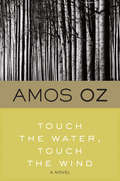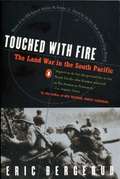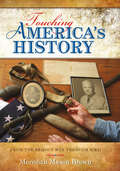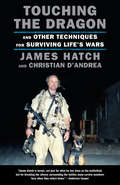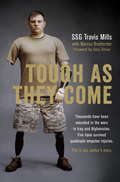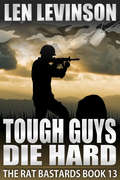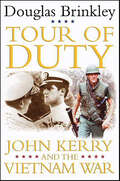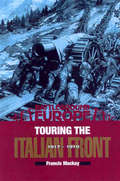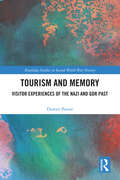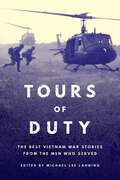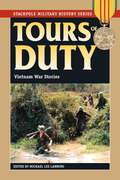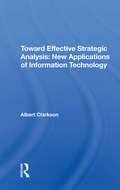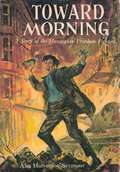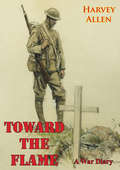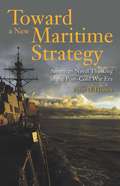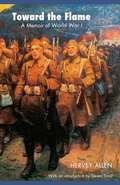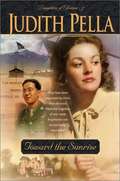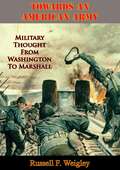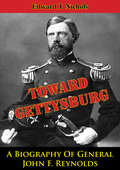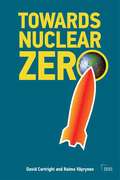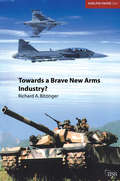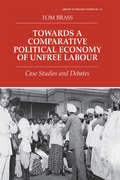- Table View
- List View
Touch the Water, Touch the Wind: A Novel
by Amos OzThe third novel from the international bestselling author of Judas. “A profusion of delightful passages couched in unfailingly lovely language.” —The New York Times Book Review1939. As the Nazis advance into Poland, a Jewish mathematician and watchmaker named Pomeranz escapes into the wintry forest, leaving behind his beautiful, intelligent wife, Stefa. After the war, having evaded the concentration camps, they begin to build new lives; Stefa in Stalin’s Russia and Pomeranz in Israel, where, as they move toward reunion, another war is brewing. An intricate tale of people seeking escape from a hostile world in thrillingly fantastical ways.“Lyrical . . . Its youthfulness and energy are exhilarating.” —The New Yorker“A masterful aggregate of philosophical speculation, witty social commentary and solid story telling.” —Kirkus Reviews“An outstandingly rich book . . . a pleasure to read.” —Times Literary Supplement
Touched With Fire: The Land War In The South Pacific
by Eric M. BergerudA brilliant history of the land battles in the Pacific theater of World War II, with stirring personal accounts of the horrifying struggle between the Japanese and Allied forces. The horrors of WWII in the South Pacific extended far beyond the detonation of atomic bombs. In this revelatory portrayal of the lives of the regular infantrymen who struggled to contain the Japanese advance, Eric Bergerud has given us a compelling and chilling record of the incredible hardships endured by these soldiers, and the heroic efforts that resulted in the reversal of the course of the war. Bergerud spent hundreds of hours interviewing the last surviving veterans of this remarkable campaign, and he has placed their personal experiences at the center of his analysis of military strategy. "Aspires to do for the ground war in the South Pacific what Keegan achieved in Six Armies in Normandy."--Los Angeles Times
Touching America's History: From the Pequot War Through WWII (Encounters: Explorations in Folklore and Ethnomusicology)
by Meredith Mason BrownObjects that make the past feel real, from a stone axe head to a piece of John Brown&’s scaffold—includes photos. History isn&’t just about abstract &“isms&”—it&’s the story of real events that happened to real people. In Touching America&’s History, Meredith Mason Brown uses a collection of such objects, drawing from his own family&’s heirlooms, to summon up major developments in America&’s history. The objects range in date from a Pequot stone axe head, probably made before the Pequot War in 1637, to the western novel Dwight Eisenhower was reading while waiting for the weather to clear so the Normandy Invasion could begin, to a piece of a toilet bowl found in the bombed-out wreckage of Hitler&’s home in 1945. Among the other historically evocative items are a Kentucky rifle carried by Col. John Floyd, killed by Indians in 1783; a letter from George Washington explaining why he will not be able to attend the Constitutional Convention; shavings from the scaffold on which John Brown was hanged; a pistol belonging to Gen. William Preston, in whose arms Gen. Albert Sidney Johnston bled to death after being shot at the Battle of Shiloh; and the records of a court-martial for the killing by an American officer of a Filipino captive during the Philippine War. Together, these objects call to mind nothing less than the birth, growth, and shaping of what is now America. &“Clearly written, buttressed by maps and portraits, Brown's book regales while showing the objectivity and nuance of a historian.&”—Library Journal &“A whole new way of doing history…a novel form of story-telling.&”—Joseph J. Ellis, Pulitzer Prize-winning author of Founding Brothers: The Revolutionary Generation
Touching the Dragon: And Other Techniques for Surviving Life's Wars
by James Hatch Christian D'AndreaFrom former special ops Navy SEAL senior chief; master naval parachutist (four Bronze Stars with Valor, Navy and Marine Corps Medal recipient, etc.); fighter in 150 missions (Iraq, Afghanistan, Bosnia, Africa); expert military dog trainer and handler whose SEAL dogs were partners and medal winners--a fierce, moving tale of a return from hell, being badly wounded on a special ops mission that ended his two-decades-long military career, his searing recovery, and the struggle to live life off the speeding train of war.In Touching the Dragon, James Hatch, Naval Special Warfare Operator, expert commando, tactical master in deadly operations, twenty-four years in service to his country (he enlisted in the Army National Guard at age seventeen), writes of his years of military service, from joining the Navy at eighteen, becoming a SEAL, to his joining the Naval Special Warfare Development group ("If I died in a gunfight, it would be doing something I loved"). He writes of the harrowing secret missions (Iraq, Bosnia, Africa); and of the fateful final mission (Afghanistan), that left him badly shot (a bullet exploding through his femur and out the back of his leg) as Hatch and his SEAL team crew were attempting to rescue a rogue soldier--Pvt. Bowe Bergdahl, who deserted his post, was captured by Al Qaida and Taliban militants, and was set to be smuggled to a part of the world where Americans could never reach him. Hatch writes of the horrific wound to his leg; of having no choice but to end his military career; of coming home to the country he'd spent his life defending; of the ordeal of getting well physically (eighteen surgeries; twelve months of recovery; learning to walk again); of having to find out who he was as a man apart from the chaotic world of special operations missions; of days and months of despair, alcoholism, the pull toward suicide; and of finally, through love of family, friends, soldiers, and his specially trained military dogs, touching the dragon, of going through the fear of feeling unfit for society, of finding a purpose and a way back to life.
Tough As They Come
by Marcus Brotherton Gary Sinise Travis MillsThousands have been wounded in the wars in Iraq and Afghanistan. Five have survived quadruple amputee injuries. This is one soldier's story. Thousands of soldiers die year to defend their country. United States Army Staff Sergeant Travis Mills was sure that he would become another statistic when, during his third tour of duty in Afghanistan, he was caught in an IED blast four days before his twenty-fifth birthday. Against the odds, he lived, but at a severe cost--Travis became one of only five soldiers from the wars in Afghanistan and Iraq to survive a quadruple amputation. Suddenly forced to reconcile with the fact that he no longer had arms or legs, Travis was faced with a future drastically different from the one he had imagined for himself. He would never again be able to lead his squad, stroke his fingers against his wife's cheek, or pick up his infant daughter. Travis struggled through the painful and anxious days of rehabilitation so that he could regain the strength to live his life to the fullest. With enormous willpower and endurance, the unconditional love of his family, and a generous amount of faith, Travis shocked everyone with his remarkable recovery. Even without limbs, he still swims, dances with his wife, rides mountain bikes, and drives his daughter to school. Travis inspires thousands every day with his remarkable journey. He doesn't want to be thought of as wounded. "I'm just a man with scars," he says, "living life to the fullest and best I know how."From the Hardcover edition.
Tough As They Come
by Marcus Brotherton Gary Sinise Travis MillsThousands have been wounded in the wars in Iraq and Afghanistan. Five have survived quadruple amputee injuries. This is one soldier's story. Thousands of soldiers die year to defend their country. United States Army Staff Sergeant Travis Mills was sure that he would become another statistic when, during his third tour of duty in Afghanistan, he was caught in an IED blast four days before his twenty-fifth birthday. Against the odds, he lived, but at a severe cost--Travis became one of only five soldiers from the wars in Afghanistan and Iraq to survive a quadruple amputation. Suddenly forced to reconcile with the fact that he no longer had arms or legs, Travis was faced with a future drastically different from the one he had imagined for himself. He would never again be able to lead his squad, stroke his fingers against his wife's cheek, or pick up his infant daughter. Travis struggled through the painful and anxious days of rehabilitation so that he could regain the strength to live his life to the fullest. With enormous willpower and endurance, the unconditional love of his family, and a generous amount of faith, Travis shocked everyone with his remarkable recovery. Even without limbs, he still swims, dances with his wife, rides mountain bikes, and drives his daughter to school. Travis inspires thousands every day with his remarkable journey. He doesn't want to be thought of as wounded. "I'm just a man with scars," he says, "living life to the fullest and best I know how."From the Hardcover edition.
Tough Choices: A Story of the Vietnam War
by Nancy AntleSamantha finds herself torn by her loyalty to her two brothers, one a soldier recently returned from the war in Vietnam and the other a war protester.
Tough Guys Die Hard: Tough Guys Die Hard (The Rat Bastards Series #13)
by Len LevinsonThe world is their war zone! The war's never over for the battle-toughened Rat Bastards. From one jungle hell to another, they strike raw terror and drive razor-sharp bayonets into the heart of their enemies. Always in the thick of the fight, they hit hard and die harder. And when a new band of misfits joins their ranks, you can hear the panic buttons getting pushed all the way to Tokyo. The Rat Bastards. Turning losers into hell-bent heroes.
Tour Guides at Memorial Sites and Holocaust Museums: Empirical Studies in Europe, Israel, North America and South Africa (Holocaust Education – Historisches Lernen – Menschenrechtsbildung)
by Anja BallisIn this volume, contributors reflect on how to teach and mediate difficult history from the perspectives of guides. Too often, their activities are undervalued and taken for granted. Guides represent an important, often forgotten group of educators. This volume takes a global view on guiding at memorial sites and museums in Europe, North America, and South Africa. The contributors to this volume show from different research traditions that it is worth understanding more about the guides’ personal interests, their motivations, and their concept of guiding. Authors apply methodologies from the social sciences to describe the guides’ point of view. Complementing the various approaches in tour guide research, a detailed linguistic analysis sheds light on a survivor’s testimony echoed in the guides’ language. The studies gathered in this volume open up an orientation for further approaches to tour guiding based on and centered around “authentic” materials from guides.
Tour of Duty: John Kerry and the Vietnam War
by Douglas BrinkleyOne of our most acclaimed historians explores the decorated military service of one of America’s most intriguing politicians—the leading Democratic presidential candidate for 2004—and its profound effects on his career and lifeIn Tour of Duty, Brinkley explores Senator John Kerry’s career and deftly deals with such explosive issues as U.S. atrocities in Vietnam and the bombing of Cambodia. Using new information acquired from the recently released Nixon tapes, Brinkley reveals how White House aides Charles Colson and H.R. Haldeman tried to discredit Kerry. Refusing to be intimidated, Kerry started running for public office, eventually becoming a U.S. Senator from Massachusetts. Covering more than four decades, this is the first full-scale definitive account of Kerry’s journey from war to peace. In writing this riveting, action-packed narrative, Brinkley has drawn on extensive interviews with virtually everyone who knew Kerry well in Vietnam. Kerry also relegated to Brinkley his letters home from Vietnam and his voluminous “war notes” journals, notebooks, and personal reminiscences written during and shortly after the war. This material was provided without restriction, to be used at Brinkley’s discretion, and has never before been published.
Touring the Italian Front, 1917–1919 (Battleground Europe)
by Francis MackayThe guide describes the ground and operations covered by the British, French and US Expeditionary Forces deployed from France to the area North of Venice between November 1917 and Spring 1919. These Forces supported the Italians after their disastrous defeat at Caporetto and helped stem the Austrian and German onslaught.This is the first guide to the Allied contribution and the Piave Defence line. It also covers the rear areas - supply and repair services, training and recreation, and describes the movement to Italy and subsequent service and care of the 16,000 British and 20,000 French horses and mules. The US contribution has never been adequately described before.
Tourism and Memory: Visitor Experiences of the Nazi and GDR Past (Routledge Studies in Second World War History)
by Doreen PastorThis book considers tourism to memorial sites from a visitor’s point of view, challenging established theories in tourism and memory studies by critically appraising Germany’s often celebrated memory culture. Based on visitor observations and exit interviews, this book examines how domestic and international visitors negotiate their visits to the concentration camp memorials Ravensbrück and Flossenbürg, the House of the Wannsee Conference and the former Stasi prison Bautzen II. It argues that memorial sites are melting pots where family, national and global narratives meet. For German visitors, the visit to memorial sites is a confrontation with Germany's responsibility for the two dictatorships while for international visitors it can be a form of 'seeing is believing'. Ultimately, it is the immediacy of the space that is the most important part of the visit. Rooted in an interdisciplinary approach, this book will be of interest to academics and students in German Studies, Tourism and Heritage Studies, Museum Studies, Public History, and Memory Studies.
Tours of Duty: The Best Vietnam War Stories from the Men Who Served
by Michael Lee LanningThese are the stories Vietnam vets tell over beers at Legion halls and VFW posts—stories of young men tangled up in the chaos of landing zones and nameless jungle hills, in the boredom of base camps, in the confusion of a controversial war. Raw, often gut-wrenching, sometimes funny, these war stories describe slices of individual tours of duty, from the firefights to the friendships, and capture the kaleidoscope of the American experience in Vietnam.
Tours of Duty: Vietnam War Stories (Stackpole Military History Series)
by Michael Lee LanningThese are the stories Vietnam vets tell each other at reunions and over beers.
Toward Effective Strategic Analysis: New Applications Of Information Technology
by Albert ClarksonExploring the future of strategic analysis, this book identifies problems at the heart of the historical U.S. failure to perform effective strategic analysis, then explains and dramatizes how new applications of information technology can make significant progress possible. Certain specific limitations of human memory, says the author, are major ca
Toward Morning: A Story Of The Hungarian Freedom Fighters
by Alta Halverson SeymourOriginally published in 1961, this book tells the vivid story of 14-year-old Teresa Nagy and her family, as they join the Hungarian Freedom Fighters and live through the terror of the Hungarian Revolution of 1956.The reader is taken on a dramatic journey and relives the dangers and excitement of one family’s flight to the safety of the Austrian border.A gripping read.
Toward The Flame: A War Diary (classic Reprint)
by Hervey AllenChronicles the experiences of the Twenty-Eighth Division in the summer of 1918 through the eyes of Lieutenant Hervey Allen and men, made up primarily of Pennsylvania National Guardsmen, who saw extensive action on the Western Front. The story begins with the 28th marching inland from the French coast and ends with their participation in the disastrous battle for the village of Fismette. Allen was a talented observer, and the men with whom he served emerge as well-rounded characters against the horrific backdrop of the war.
Toward a New Maritime Strategy
by Peter D. HaynesThe book examines the evolution of American naval thinking in the post-Cold War era. It recounts the development of the U. S. Navy’s key strategic documents from the fall of the Berlin Wall in 1989 to the release in 2007 of the U. S. Navy’s maritime strategy, A Cooperative Strategy for 21st Century Seapower. An insightful and penetrating intellectual history, it critically analyzes the Navy’s way of thinking and ideas, and recounts how they interacted with those that govern U. S. strategy to shape the course of U. S. naval strategy in the post-Cold War era. The book explains how the Navy arrived at its current strategic outlook and why it took nearly two decades for the Navy to develop a maritime strategy in an era in which the relative saliency of such should have been more apparent to Navy leaders. The author, a Navy captain, doesn’t shy from taking to task the institution and its leaders for their narrow worldview and failure to understand the virtues and contributions of American sea power, particularly in an era of globalization. It describes the reasons behind the Navy’s late development of a maritime strategy during the post-Cold War era. It recounts the origins and evolution of the Navy’s distinctive way of thinking and ideas about sea power since before the Second World War, particularly how they shaped and were shaped by the Navy’s Cold War experiences. It argues that the Navy’s way of thinking and ideas, and how they interacted those that governed U. S. strategy, bounded and channeled U. S. naval strategy away from a maritime approach as they had during the Cold War. It took an implausible series of events for one to emerge, including a losing war in Iraq--that called into question long-standing assumptions about U. S. strategy, threatened the Navy’s relevance, and brought about a systemically oriented U. S. strategic approach--and the appearance of two maritime-minded Navy leaders. It focuses on the process by which the Navy developed its strategic documents, the process where institutional ideas are assembled, negotiated, and reshaped in light of other influences--i. e. , the direction of U. S. strategy, budgetary constraints, perceived threats, and the competing interests of other domestic and institutional actors--because even though the subject is American naval thinking (and here it must be emphasized that the concept itself is somewhat metaphorical as only people can think), that is how real strategy is made.
Toward the Flame: A Memoir of World War I
by Hervey AllenThis book vividly chronicles the experiences of the Twenty-eighth Division in the summer of 1918. Made up primarily of Pennsylvania National Guardsmen, the Twenty-eighth Division saw extensive action on the Western Front. The story begins with Lieutenant Allen and his men marching inland from the French coast and ends with their participation in the disastrous battle for the village of Fismette.
Toward the Sunrise (Daughters of Fortune #3)
by Judith PellaContinuing the Dramatic DAUGHTERS OF FORTUNE Series-Historical Fiction at Its Best! In the midst of bitter conflict at home and abroad, Toward the Sunrise follows the paths of three sisters caught in the heartbreaking consequences of war and of prejudice. It is the summer of 1942, and on three different continents the daughters of newspaper tycoon Keagan Hayes are caught in chaos--within and without. A world at war and a family in turmoil have thrown the three sisters into physical and emotional traumas that severely test faith and fortitude. In Los Angeles, Jackie’s Japanese-American husband is sent to an internment camp. In the Philippines, Blair is captured by the Japanese and imprisoned. In Russia, Cameron is arrested and forced to leave the country. Can each young woman find strength to endure the hardships inflicted upon her and to maintain confidence that God is indeed writing the pages of all their lives? A Riveting Tale of Love and Loss, Triumph and Tragedy.
Towards An American Army: Military Thought From Washington To Marshall
by Russell F. WeigleyThis book is a history of controversies that have surrounded the growth of the United States Army, controversies that have flared over the inextricably related questions of how to attain maximum military security for the United States and how to form an army that will be appropriate to and not subversive of American democratic society.This book offers some measure of information on the attitudes and thought processes that have been traditional and habitual among American professional soldiers. Especially, it reveals something of their customary approach to issues of military policy where such issues merge with those of national policy in general. And to know something about the customary approach of military men to the broadest issues of military and national policy is also of manifest value to the present.
Towards Gettysburg: A Biography Of General John F. Reynolds
by Edward J. NicholsThe definitive biography of Major-General John F. Reynolds, one of the finest generals to command in the Union ranks during the Civil War. The book follows Reynolds' exploits from childhood through his cadet years at West Point, active service in the Mexican War, and then in the Civil War. Universally respected by the men under his command and even within the Confederate ranks; he fought with skill and courage despite often being handicapped by the Union High Command. His lasting legacy rests on his superlative efforts on the first day of the Battle of Gettysburg, arriving in the nick of time to stall and then halt the Confederate advance at the cost of his life."A model of its kind."--New York Times Book Review
Towards Nuclear Zero (Adelphi series)
by David Cortright Raimo VäyrynenRarely in the atomic age have hopes been raised as high as they are now for genuine progress toward disarmament. The new receptivity reflected in the policy declarations of many governments was sparked by a wave of private initiatives led by former senior policy leaders in many countries. This book examines practical steps for achieving progress toward disarmament, realistically assessing both challenges and opportunities associated with achieving a world without nuclear weapons. The book places the current debate over nuclear abolition in the context of urgent non-proliferation priorities and the need to prevent nuclear weapons from falling into the hands of extremist regimes and terrorists. It examines the reasons why more than two dozen states have given up nuclear programs over the years and distils lessons from the end of the cold war to offer policy recommendations for moving toward lessened global reliance on nuclear weapons. Also included are in-depth analyses of proliferation challenges and disarmament opportunities in North Korea and Iran. The book concludes with a detailed roadmap for moving progressively toward global nuclear zero. It proposes a new international security regime based on shared missile defences, nonweaponized deterrence and greater efforts to enhance transnational cooperation.
Towards a Brave New Arms Industry? (Adelphi series)
by Richard BitzingerIn the post-Cold War era, most countries have been forced to radically reduce their arms industries, and abandoned self-sufficiency in favour of a subordinate role in an increasingly globalized worldwide defence industry. This has significant implications for the future of armaments production, for proliferation, and for arms control.
Towards a Comparative Political Economy of Unfree Labour: Case Studies and Debates
by Tom Brass Dr Tom BrassMany works about agragarian change in the Third World assumes that unfree relations are to be eliminated in the course of capitalist development. This text argues that the incidence of bonded labour is greater than supposed, and that in certain situations rural employers prefer an unfree workforce.
